how much should I pay for this respray - £500?
Discussion
Hi,
I have spent the last 4 weeks doing the bodywork on my 68 mustang. I have gone through several cycles of: Block flat with dura-blocks, prime, guide coat, block flat, fill, prime, guide coat, block flat, repeat, repeat, repeat.....
The last time I blocked it flat was with P400 dry and there's not a ripple on the car now. I am very pleased with the bodywork.
Unfortunately my workshop isn't really suitable for applying the topcoat. Its fine for primering, but there's too much dirt and dust and not enough extraction for topcoat.
I have bought the paint and lacquer already (House of color)
I am looking for a painter who has a nice booth to apply the topcoat and lacquer. It should be doable in about 4hrs or thereabouts but or course will have to be left in the booth for longer to dry
There is zero preparation work for the painter to do and there's not even any time consuming masking up to do as the interior is stripped. I'm not even bothered about them doing the panel gaps really.
They literally just have to: roll it into a booth, degrease it, tack cloth it, shoot the basecoat, shoot the clear.
What do you think is a reasonable price for this? I was thinking that £500 should be about right and I offered that to a local painter, who accepted but he's had it a week and hasn't touched it yet (promised it would be done by now) and is full of bulls t excuses so I'm going to fetch it back later this week.
t excuses so I'm going to fetch it back later this week.
A friend told me it was because I wasn't paying enough and that "proper painters make a lot more than that"
What do you guys think? is £500 (cash in hand) for a half days work too cheap for a good painter?
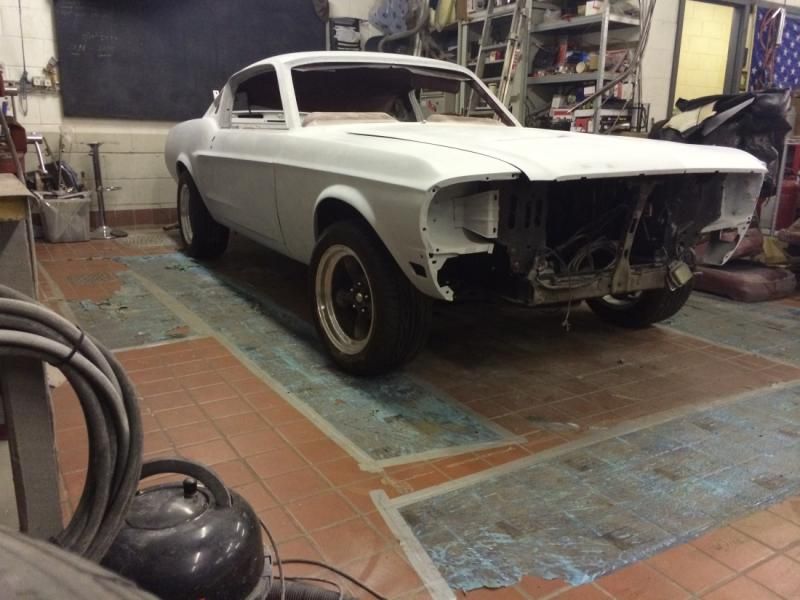
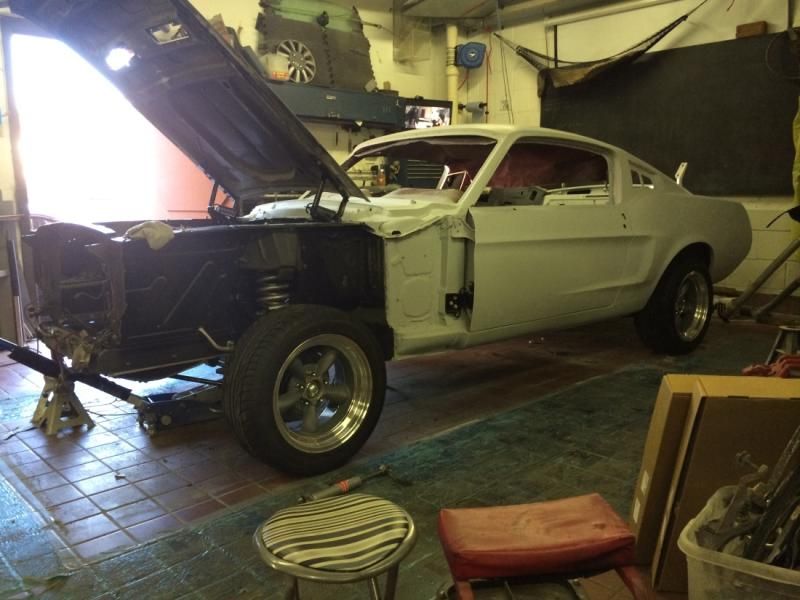
I have spent the last 4 weeks doing the bodywork on my 68 mustang. I have gone through several cycles of: Block flat with dura-blocks, prime, guide coat, block flat, fill, prime, guide coat, block flat, repeat, repeat, repeat.....
The last time I blocked it flat was with P400 dry and there's not a ripple on the car now. I am very pleased with the bodywork.
Unfortunately my workshop isn't really suitable for applying the topcoat. Its fine for primering, but there's too much dirt and dust and not enough extraction for topcoat.
I have bought the paint and lacquer already (House of color)
I am looking for a painter who has a nice booth to apply the topcoat and lacquer. It should be doable in about 4hrs or thereabouts but or course will have to be left in the booth for longer to dry
There is zero preparation work for the painter to do and there's not even any time consuming masking up to do as the interior is stripped. I'm not even bothered about them doing the panel gaps really.
They literally just have to: roll it into a booth, degrease it, tack cloth it, shoot the basecoat, shoot the clear.
What do you think is a reasonable price for this? I was thinking that £500 should be about right and I offered that to a local painter, who accepted but he's had it a week and hasn't touched it yet (promised it would be done by now) and is full of bulls
 t excuses so I'm going to fetch it back later this week.
t excuses so I'm going to fetch it back later this week. A friend told me it was because I wasn't paying enough and that "proper painters make a lot more than that"
What do you guys think? is £500 (cash in hand) for a half days work too cheap for a good painter?


Couple of more things to think about, and this come from just under 35 years’ experience, and my own restoration shop:-
The masking process no only protects the rest of the panels and car from over spray it is also to stop dust and c$ap from flying up everywhere when painting, and no matter what you say or do there will be dust lurking somewhere, so will you be happy with contamination in the final colour, it’s a simple yes or no? So there is a 2-4 hour complete masking job alone
You say you have blocked it with 400 dry? Well unless you were painting it white (and then I would worry) it want at least a 600 wet for solid colours and 600 to 800 ( or even finer ) wet for a fine metallic or pearl.
Also from the painters perspective does he know what the undercoat/primer is and is it compatible with the House of Kolor material, if it pickles or shrinks who is responsible ?
If it is the House of Kolor finishing system are you going with their base application ( silver, gold, white etc) , then finish colour and then clear coat ? as if you are then this is a lot more than a mornings work and the booth will be out of operation for more than just a morning. We have done a few of these and they can be long winded.
If it was mine and the painter agreed to do this without question I would worry and not take it there. Perhaps he hasn’t started it yet because he has had a long think about it?
Have a chat to a few more and get their perspective on it, discuss the issues and problem that might happen and how they/you would overcome this.
Anyway just trying to put a body shops perspective on it, and also to save you both a lot of tears and all of your hard work prepping.
The masking process no only protects the rest of the panels and car from over spray it is also to stop dust and c$ap from flying up everywhere when painting, and no matter what you say or do there will be dust lurking somewhere, so will you be happy with contamination in the final colour, it’s a simple yes or no? So there is a 2-4 hour complete masking job alone
You say you have blocked it with 400 dry? Well unless you were painting it white (and then I would worry) it want at least a 600 wet for solid colours and 600 to 800 ( or even finer ) wet for a fine metallic or pearl.
Also from the painters perspective does he know what the undercoat/primer is and is it compatible with the House of Kolor material, if it pickles or shrinks who is responsible ?
If it is the House of Kolor finishing system are you going with their base application ( silver, gold, white etc) , then finish colour and then clear coat ? as if you are then this is a lot more than a mornings work and the booth will be out of operation for more than just a morning. We have done a few of these and they can be long winded.
If it was mine and the painter agreed to do this without question I would worry and not take it there. Perhaps he hasn’t started it yet because he has had a long think about it?
Have a chat to a few more and get their perspective on it, discuss the issues and problem that might happen and how they/you would overcome this.
Anyway just trying to put a body shops perspective on it, and also to save you both a lot of tears and all of your hard work prepping.
Above /\/\/\/\ beat me to it.
we took 2 man days fully masking off a car we restored to make everything perfectly "sealed" which in turn saves loads of work at the denibbing polishing stage.
to add to above post
the fact you sanded the primer stages many times "dry" will mean that the car going to need many hours of care cleaning, masking, recleaning, and then finally degreasing to remove all the dust.
the cleaing process we would do outside firstly, then into the oven and repeat (not the masking of course0.
lets say your many primer stages you done have slight comtamination from the surrounding areas (even hair products, plus skin care have nasty stuff for paint contamination) as i am sure your workshop has many chemicals which can hold oil based, silcone based products.
I would suggest your car may need an isolator type primer (not high build primer) before painting in base colour, useage of some primers (solvent base 2K) before applying colour will highlight any reactions too.
At least this can be fixed IF there are any issues before wasting your expensive colour and top coat.
HTH Kelly
we took 2 man days fully masking off a car we restored to make everything perfectly "sealed" which in turn saves loads of work at the denibbing polishing stage.
to add to above post
the fact you sanded the primer stages many times "dry" will mean that the car going to need many hours of care cleaning, masking, recleaning, and then finally degreasing to remove all the dust.
the cleaing process we would do outside firstly, then into the oven and repeat (not the masking of course0.
lets say your many primer stages you done have slight comtamination from the surrounding areas (even hair products, plus skin care have nasty stuff for paint contamination) as i am sure your workshop has many chemicals which can hold oil based, silcone based products.
I would suggest your car may need an isolator type primer (not high build primer) before painting in base colour, useage of some primers (solvent base 2K) before applying colour will highlight any reactions too.
At least this can be fixed IF there are any issues before wasting your expensive colour and top coat.
HTH Kelly
Hi Guys,
thanks for the responses. there's some stuff I hadn't considered here. I'll try to respond to each bit separately....
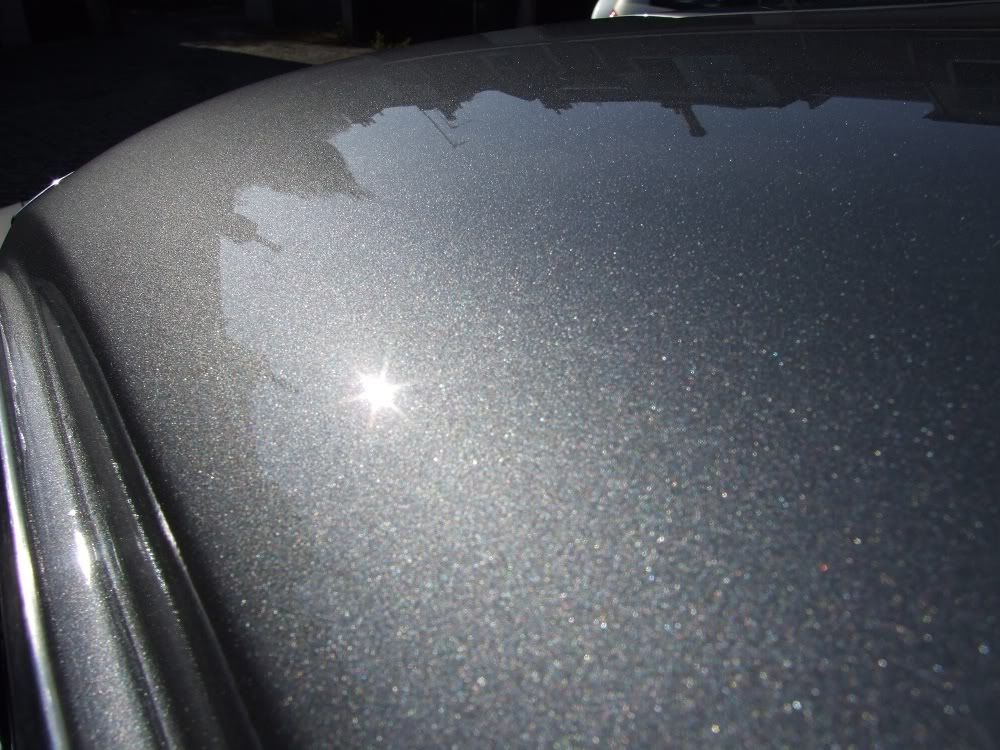
Back in the 90's I worked at Aylings boatyard building carbon/kevlar/GRP racing boats. Granted, they were mostly painted white (base and then clear), but we'd sand down the primer with P180 wet before shooting the paint. These were top-end racing boats and had to be perfect. I'm not saying this is the way of doing things, I'm just relaying an anecdote from my personal experience.
We spent about 2 hours on the phone 6 weeks ago and I was confident he had every scrap of information he needed. when I arrived he was a totally different guy than he was on the phone. it was weird. I should have just called the transporter back and followed my instinct to flee.
So the question remains... what do you think is a reasonable price for this job? if it turns out that actually, a reasonable price for this is somewhere nearer to £1000, I'll just do it myself. I have very limited ventilation on my garage so I always have to spend ages with the polisher after I've finished, but it thats the alternative, I dint think it's worth it. It takes me a very long time to earn that kind of money. Here's the kind of "booth" I usually build in my garage. This was a 66 mustang I painted white.
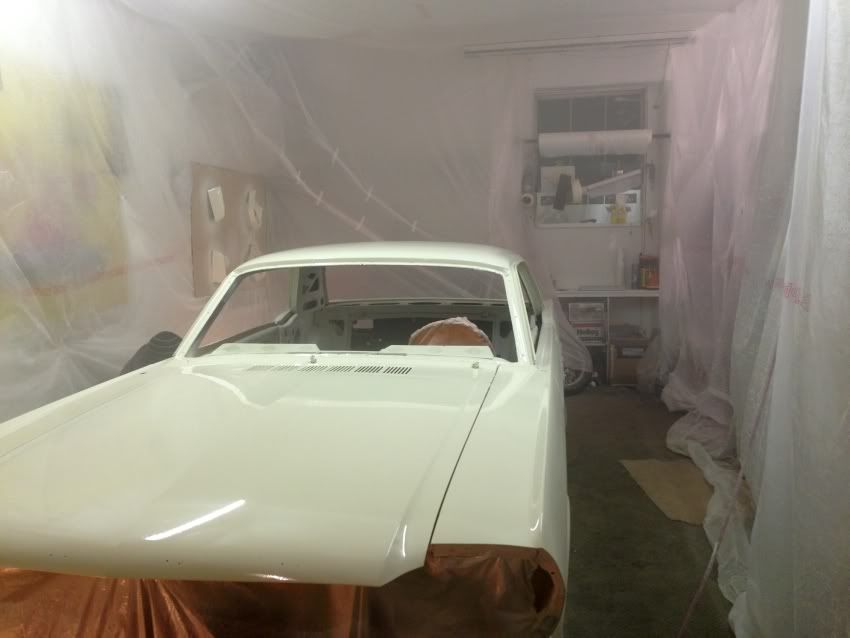
thanks for the responses. there's some stuff I hadn't considered here. I'll try to respond to each bit separately....
460dave said:
Couple of more things to think about, and this come from just under 35 years’ experience, and my own restoration shop:-
The masking process no only protects the rest of the panels and car from over spray it is also to stop dust and c$ap from flying up everywhere when painting, and no matter what you say or do there will be dust lurking somewhere, so will you be happy with contamination in the final colour, it’s a simple yes or no? So there is a 2-4 hour complete masking job alone
I didn't think of that, and it makes total sense. It takes me about 3hrs to completely mask up a mustang including sills-to-floor masks. I'm relatively quick at it because I've done 5 previous mustangs, but I get that it takes time.The masking process no only protects the rest of the panels and car from over spray it is also to stop dust and c$ap from flying up everywhere when painting, and no matter what you say or do there will be dust lurking somewhere, so will you be happy with contamination in the final colour, it’s a simple yes or no? So there is a 2-4 hour complete masking job alone
460dave said:
You say you have blocked it with 400 dry? Well unless you were painting it white (and then I would worry) it want at least a 600 wet for solid colours and 600 to 800 ( or even finer ) wet for a fine metallic or pearl.
I've heard so many different opinions from painters on this so I just go with what's worked for me in the past. The last 2 cars I've painted were done with P400 dry. One a pearl silver/grey and one gloss white (yeah I know that one doesn't count) and the car before that was done with P320 wet. All 3 cars look great and there's zero evidence of sanding scratches showing through the paint. I did this one with P400 dry and then painted it in my dusty garage but then had to spend 2 long days flatting with P1200 and polishing it, which is something I'm now considering doing again with this this car.
Back in the 90's I worked at Aylings boatyard building carbon/kevlar/GRP racing boats. Granted, they were mostly painted white (base and then clear), but we'd sand down the primer with P180 wet before shooting the paint. These were top-end racing boats and had to be perfect. I'm not saying this is the way of doing things, I'm just relaying an anecdote from my personal experience.
460dave said:
Also from the painters perspective does he know what the undercoat/primer is and is it compatible with the House of Kolor material, if it pickles or shrinks who is responsible ?
Yeah I discussed this with him at length before agreeing to use him. He said that he'd only use the House of kolor stuff over my Upol primer. (I took the car to bare metal, etch primed, then Upol high build. As with any paint job, if there's anything wrong with the finish (apart from peel/runs etc)then it's down to substandard prep and totally down to me. the paint is a standard basecoat/clearcoat. It's not one of the 3 stage applications460dave said:
If it was mine and the painter agreed to do this without question I would worry and not take it there. Perhaps he hasn't started it yet because he has had a long think about it?
yeah, could well be. Its frustrating as it has wasted a load of my time, and it's not like I've changed the game on him either. I know a lot of folk tell a painter one thing over the phone and then when they arrive start with the "while it's in the gun, can you just..." malarkey. We spent about 2 hours on the phone 6 weeks ago and I was confident he had every scrap of information he needed. when I arrived he was a totally different guy than he was on the phone. it was weird. I should have just called the transporter back and followed my instinct to flee.
460dave said:
Have a chat to a few more and get their perspective on it, discuss the issues and problem that might happen and how they/you would overcome this.
Anyway just trying to put a body shops perspective on it, and also to save you both a lot of tears and all of your hard work prepping.
I will do Dave. After all the hard work I've put in, it would be a massive shame to get it wrong at this stage. Anyway just trying to put a body shops perspective on it, and also to save you both a lot of tears and all of your hard work prepping.
kds keltec said:
Above /\/\/\/\ beat me to it.
we took 2 man days fully masking off a car we restored to make everything perfectly "sealed" which in turn saves loads of work at the denibbing polishing stage.
Wow, that seems like an extreme case. What kind of car was it? without wanting to sound flippant, I think I would probably fabricate a full set of reusable lexan masking plates to fit every aperture on a mustang in 2 days (I'm kidding but the sentiment remains). They're not a complex car to mask up. I've lost count of the number of times I've done it. takes about 3hrswe took 2 man days fully masking off a car we restored to make everything perfectly "sealed" which in turn saves loads of work at the denibbing polishing stage.
kds keltec said:
the fact you sanded the primer stages many times "dry" will mean that the car going to need many hours of care cleaning, masking, recleaning, and then finally degreasing to remove all the dust.
the cleaing process we would do outside firstly, then into the oven and repeat (not the masking of course0.
lets say your many primer stages you done have slight comtamination from the surrounding areas (even hair products, plus skin care have nasty stuff for paint contamination) as i am sure your workshop has many chemicals which can hold oil based, silcone based products.
I would suggest your car may need an isolator type primer (not high build primer) before painting in base colour, useage of some primers (solvent base 2K) before applying colour will highlight any reactions too.
At least this can be fixed IF there are any issues before wasting your expensive colour and top coat.
This is true of any pre-paint preparation. there's always a risk of contamination because we're human beings and even the oils in our skin can mess with a paint job. I've often said that it's almost like we were designed to mess up paint jobs. I know the risks and I am as careful as possible regarding contamination but I like the idea of an isolator primer, perhaps and epoxy or similar, before shooting the base wet-on-wet.the cleaing process we would do outside firstly, then into the oven and repeat (not the masking of course0.
lets say your many primer stages you done have slight comtamination from the surrounding areas (even hair products, plus skin care have nasty stuff for paint contamination) as i am sure your workshop has many chemicals which can hold oil based, silcone based products.
I would suggest your car may need an isolator type primer (not high build primer) before painting in base colour, useage of some primers (solvent base 2K) before applying colour will highlight any reactions too.
At least this can be fixed IF there are any issues before wasting your expensive colour and top coat.
So the question remains... what do you think is a reasonable price for this job? if it turns out that actually, a reasonable price for this is somewhere nearer to £1000, I'll just do it myself. I have very limited ventilation on my garage so I always have to spend ages with the polisher after I've finished, but it thats the alternative, I dint think it's worth it. It takes me a very long time to earn that kind of money. Here's the kind of "booth" I usually build in my garage. This was a 66 mustang I painted white.

Looking at your booth there why not give it a go, keep the floor nice and wet
( I assume you are using 2k )
Get an extractor fan of sorts and more overly allow the air to get in somewhere.
A simple way is to build a frame from 2”x2” size or a normal door frame, and cover it with filter medium ( can be bought from ebay on a roll ) that would be used to filter air normally, put this in the booth wall/sheet. This way the air will take the pass of least resistance and keep the majority of c£ap out.
Most people think that an extractor keeps the booth clean, not really, if the air being pulled in is full of contaminants then the finish will suffer.
Also most ovens dry quick, 20min @ 60 for most repair work, this will lead to a bit of orange peel that most of us don’t want, so you will still be in there for hours after flatting and polishing.
So why not have a go, if you can prep I’m sure you can paint. Also have a look at the LVLP guns available now, you can get a 1.3 or 1.4 tip set up for refinishing and they are very good and produce even less over spray than the HVLP.
I use a 1.8 and 2.0 for the polyester and high build undercoats and the over spray is hardly noticeable. Use about 22psi at the tip, so allow for a little drop on the line airline. Also best bit the guns are anywhere from £25 to £45, I think the 1.4 we use for small brackets, etc was about £38.
I do have a set of Devilbiss guns for major work and they run up to £380 approx, so not really something you want to try and find you don’t like, also even being an HVLP they still consume quite a bit of air (CFM)
Fastmover do a good one (LVLP), again on eBay, a small amount to pay and try.
Cheers
( I assume you are using 2k )
Get an extractor fan of sorts and more overly allow the air to get in somewhere.
A simple way is to build a frame from 2”x2” size or a normal door frame, and cover it with filter medium ( can be bought from ebay on a roll ) that would be used to filter air normally, put this in the booth wall/sheet. This way the air will take the pass of least resistance and keep the majority of c£ap out.
Most people think that an extractor keeps the booth clean, not really, if the air being pulled in is full of contaminants then the finish will suffer.
Also most ovens dry quick, 20min @ 60 for most repair work, this will lead to a bit of orange peel that most of us don’t want, so you will still be in there for hours after flatting and polishing.
So why not have a go, if you can prep I’m sure you can paint. Also have a look at the LVLP guns available now, you can get a 1.3 or 1.4 tip set up for refinishing and they are very good and produce even less over spray than the HVLP.
I use a 1.8 and 2.0 for the polyester and high build undercoats and the over spray is hardly noticeable. Use about 22psi at the tip, so allow for a little drop on the line airline. Also best bit the guns are anywhere from £25 to £45, I think the 1.4 we use for small brackets, etc was about £38.
I do have a set of Devilbiss guns for major work and they run up to £380 approx, so not really something you want to try and find you don’t like, also even being an HVLP they still consume quite a bit of air (CFM)
Fastmover do a good one (LVLP), again on eBay, a small amount to pay and try.
Cheers
Dave I reckon you're right.
I've been thinking a lot about this (I've thought about very little else for the last week) and have concluded that at the sort of money it's looking like I'd have to give someone else, I'd be better off investing cash into making my workshop more suitable for painting and just doing it myself. I took your advice and contacted two other local spray shops before giving up and reaching for a calming beer. The first guy said they only do insurance work and the second guy threw out an £1800 quote over the phone after a 30 second conversation!
After many beers, I decided to buy a second hand booth and rent it out to hobbyists like myself for £100 a day when I'm not using it. But after looking into that briefly, the legislation surrounding the industry put me off.
I like the filter in a frame idea. The only snag for me is the door opens right onto a public pavement. I guess I'd just have to either paint it in the middle of the night, or have a mate stand watch outside. I looked into extraction and saw a fan I like for £130. it moves 65 cubic metres of air per minute. I've no idea if that'd would be adequate? any advice would be greatly appreciated
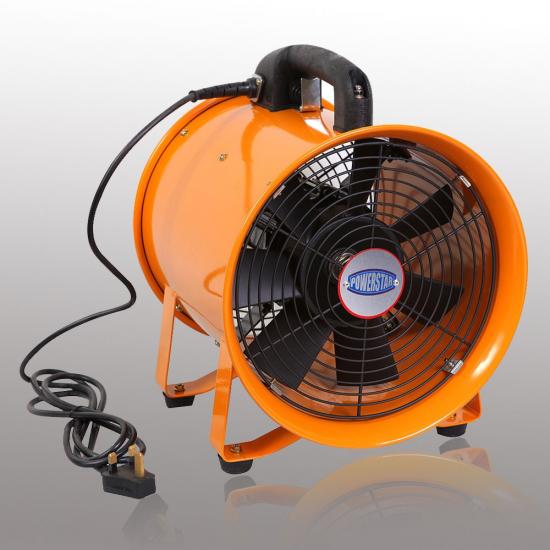
I have a LVLP gun (with a 1.6 tip) but its quite slow to use and I prefer a HVLP. I have a few, but my favourite is my Clarke AP14GF (with a 1.4 tip). I've tried quite a few guns over the years, and I like this one the best. My compressor runs a lot more with the HVLP guns but it just about copes. I have 2X water traps and a decent secondary filter/regulator.
This is the AP14GF
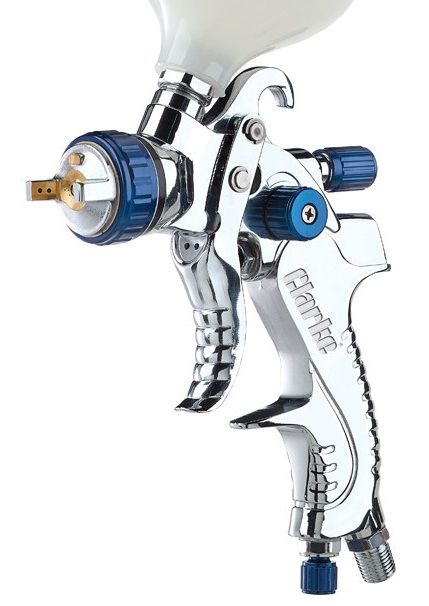
I can dial this gun in so that it will chuck out primer at a healthy rate, and adjust it back so that I can shoot gloss 2K on to my refurbed suspension/engine/drivetrain components. I don't know how well it will cope with the House of Kolor paint as I've not tried it before and am more familiar with 2K, whereas this stuff is 1K base/2K clear. I guess I'll just have to do a few practice panels and try it.
Here's my current workshop space. I moved from my last garage about a year ago (where I painted the white and silver mustangs)
I now rent an area that's part of a bigger workshop which makes doing painting a bit tricky, but not impossible.
You can see the poly sheeting I've hung from the ceiling. I have it on all 4 sides now and when it's rolled down I duct-tape the corners to try to keep the overspray out of the rest of the workshop.
You can see the Grey door in this photo. That's where I would build the frame for the fan and filter.
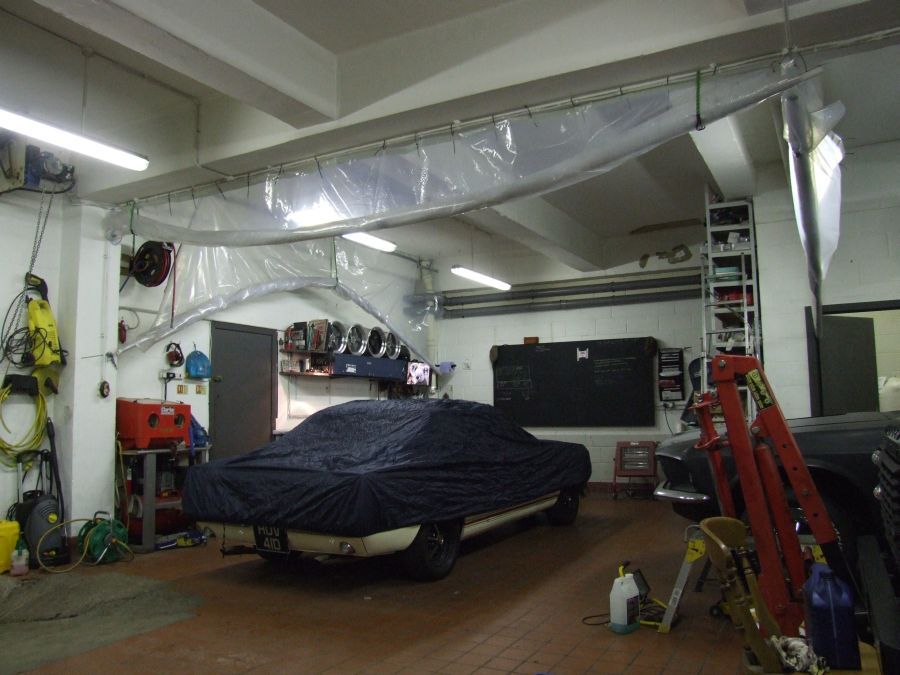
here's the current project:
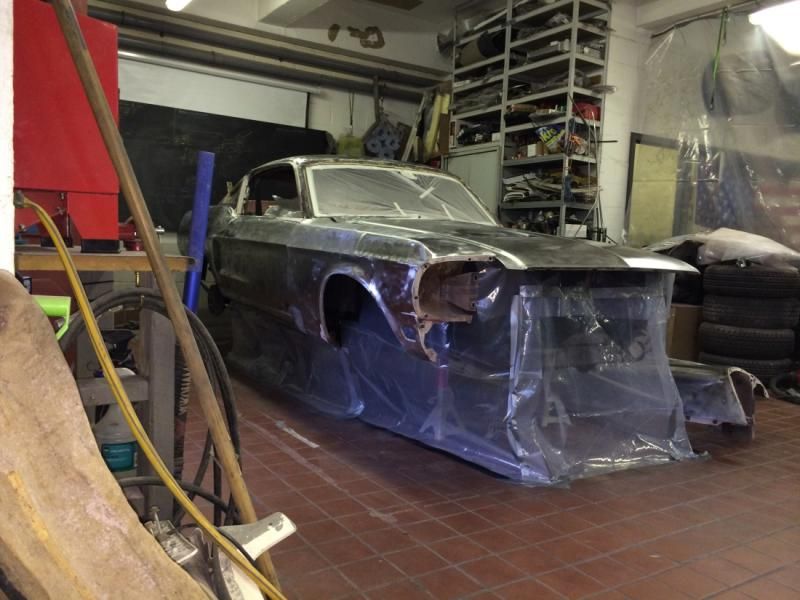
I tried out some laminate floor protector film on the floor which worked really well. Should have got more of it as there wasn't much on the roll. (screwfix)
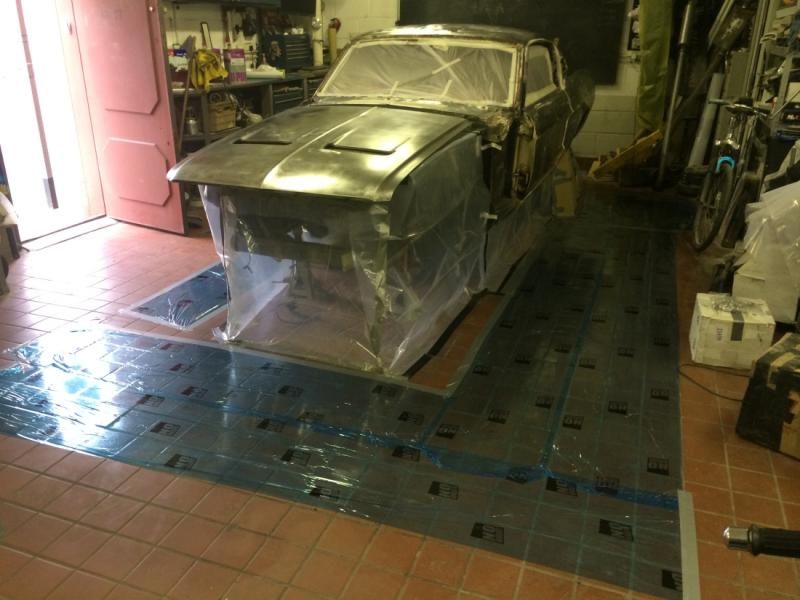
Gets dusty when you're rubbing it down. Took me 2 full days to clean the workshop properly after all the rubbing down was finished
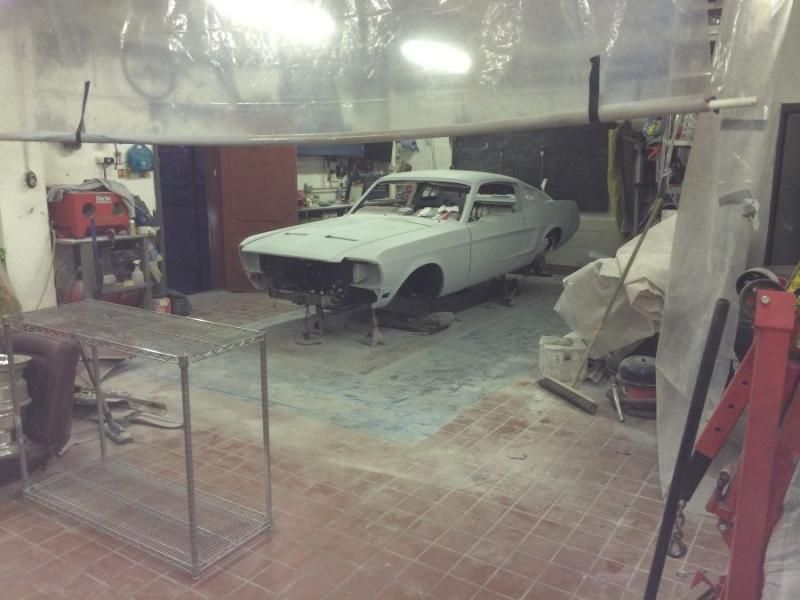
This is the engine that I've rebuilt to go into the mustang. I spent at least one whole millennium cleaning and degreasing it before shooting etch primer and then regular 2K primer, then 2K gloss black. Even though I really did go overboard with the degreasing, I'm still nervous about whether the paint will stick. I've painted all my previous engines with Hammerite but I hate the finish you get with that stuff, and it comes right off the minute you splash fuel on it.
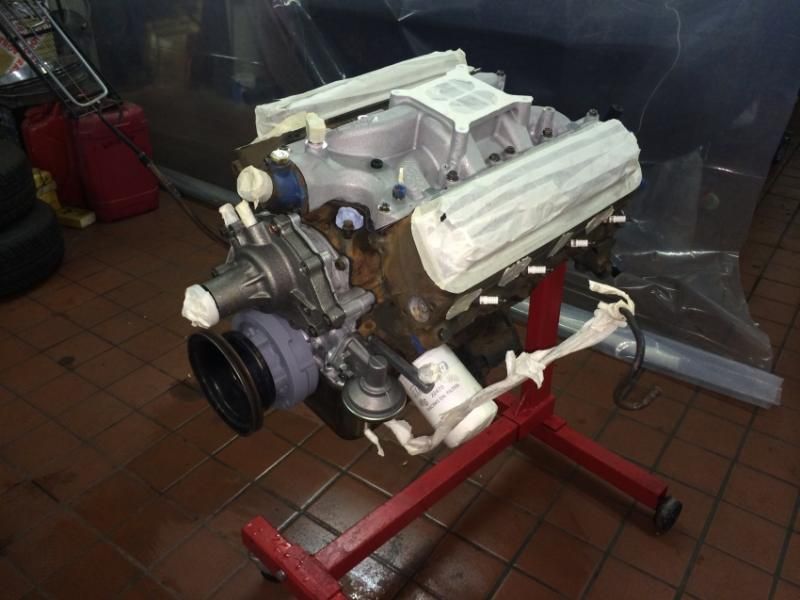
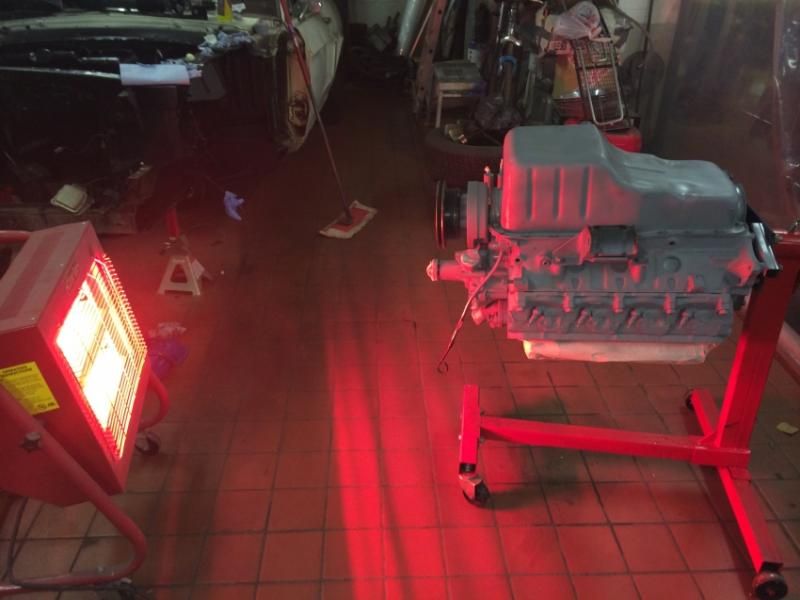
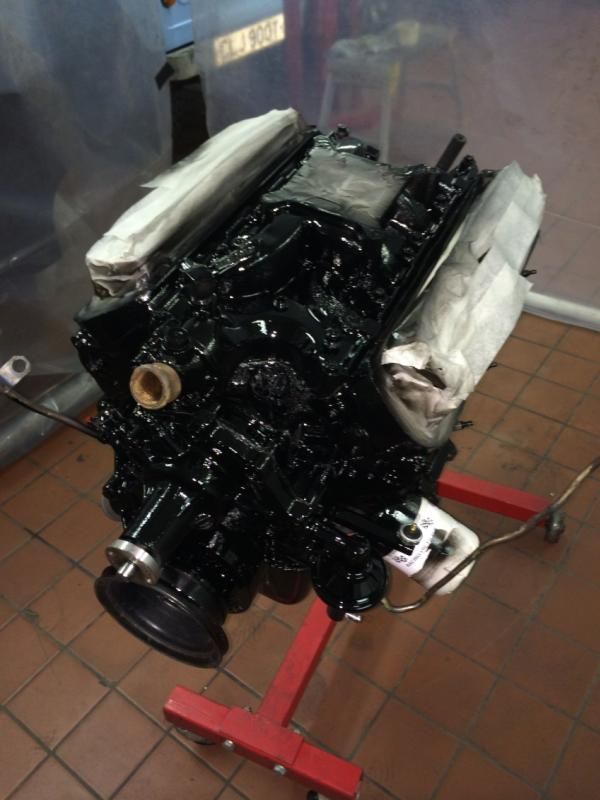
You can see my "booth" walls in this shot, rolled down to the floor. I used some standard PVC drainpipe to try to give them some rigity when I'm rolling them back up to the ceiling. It isn't perfect but it works Ok.
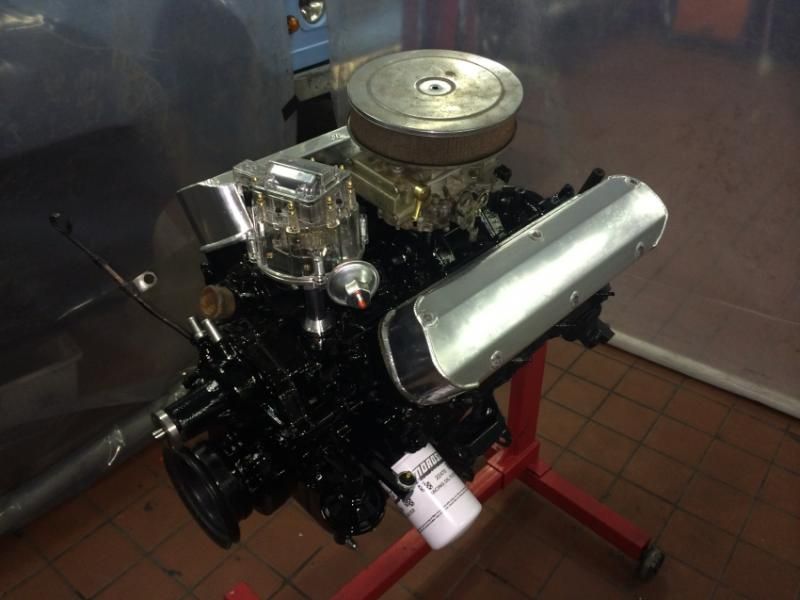
I've been thinking a lot about this (I've thought about very little else for the last week) and have concluded that at the sort of money it's looking like I'd have to give someone else, I'd be better off investing cash into making my workshop more suitable for painting and just doing it myself. I took your advice and contacted two other local spray shops before giving up and reaching for a calming beer. The first guy said they only do insurance work and the second guy threw out an £1800 quote over the phone after a 30 second conversation!
After many beers, I decided to buy a second hand booth and rent it out to hobbyists like myself for £100 a day when I'm not using it. But after looking into that briefly, the legislation surrounding the industry put me off.
I like the filter in a frame idea. The only snag for me is the door opens right onto a public pavement. I guess I'd just have to either paint it in the middle of the night, or have a mate stand watch outside. I looked into extraction and saw a fan I like for £130. it moves 65 cubic metres of air per minute. I've no idea if that'd would be adequate? any advice would be greatly appreciated

I have a LVLP gun (with a 1.6 tip) but its quite slow to use and I prefer a HVLP. I have a few, but my favourite is my Clarke AP14GF (with a 1.4 tip). I've tried quite a few guns over the years, and I like this one the best. My compressor runs a lot more with the HVLP guns but it just about copes. I have 2X water traps and a decent secondary filter/regulator.
This is the AP14GF

I can dial this gun in so that it will chuck out primer at a healthy rate, and adjust it back so that I can shoot gloss 2K on to my refurbed suspension/engine/drivetrain components. I don't know how well it will cope with the House of Kolor paint as I've not tried it before and am more familiar with 2K, whereas this stuff is 1K base/2K clear. I guess I'll just have to do a few practice panels and try it.
Here's my current workshop space. I moved from my last garage about a year ago (where I painted the white and silver mustangs)
I now rent an area that's part of a bigger workshop which makes doing painting a bit tricky, but not impossible.
You can see the poly sheeting I've hung from the ceiling. I have it on all 4 sides now and when it's rolled down I duct-tape the corners to try to keep the overspray out of the rest of the workshop.
You can see the Grey door in this photo. That's where I would build the frame for the fan and filter.

here's the current project:

I tried out some laminate floor protector film on the floor which worked really well. Should have got more of it as there wasn't much on the roll. (screwfix)

Gets dusty when you're rubbing it down. Took me 2 full days to clean the workshop properly after all the rubbing down was finished

This is the engine that I've rebuilt to go into the mustang. I spent at least one whole millennium cleaning and degreasing it before shooting etch primer and then regular 2K primer, then 2K gloss black. Even though I really did go overboard with the degreasing, I'm still nervous about whether the paint will stick. I've painted all my previous engines with Hammerite but I hate the finish you get with that stuff, and it comes right off the minute you splash fuel on it.



You can see my "booth" walls in this shot, rolled down to the floor. I used some standard PVC drainpipe to try to give them some rigity when I'm rolling them back up to the ceiling. It isn't perfect but it works Ok.

Edited by Nicklouse10 on Thursday 14th August 14:41
It looks fine, as long as you can reduce airborne contaminants as much as possible that will do fine.
I cover my walls as well with either static ploy roll or tape up normal poly roll. This isn’t any better than the spray area walls themselves but it does stop me having to refinish and clean them after a few months etc, it’s surprising how much paint and crap gets on the walls.
The fan looks fine, not sure about mine, it is approx 40” in dia with an external motor, so any extracted material doesn’t go over the motor directly.
Simple way to protect the fan is to again make up a very simple wooden frame with a wire ( chicken wire or some sort) support and again use a cheap filter medium on a roll across this. Use a couple of bungees to hold the frame to the fan, and hey presto you have a filter to protect the fan.
2k we have found was ok on engines, trick was to keep the primer/etch as thin as possible, then we used satin black as it just seemed cope with the heat better and didn’t look so bling in the engine bays.
If we were doing the early MG’s with the Damask red engines we would get normal 2k finish and then add a small % of matting agent.
What you are doing looks fine, keep up the good work.
I cover my walls as well with either static ploy roll or tape up normal poly roll. This isn’t any better than the spray area walls themselves but it does stop me having to refinish and clean them after a few months etc, it’s surprising how much paint and crap gets on the walls.
The fan looks fine, not sure about mine, it is approx 40” in dia with an external motor, so any extracted material doesn’t go over the motor directly.
Simple way to protect the fan is to again make up a very simple wooden frame with a wire ( chicken wire or some sort) support and again use a cheap filter medium on a roll across this. Use a couple of bungees to hold the frame to the fan, and hey presto you have a filter to protect the fan.
2k we have found was ok on engines, trick was to keep the primer/etch as thin as possible, then we used satin black as it just seemed cope with the heat better and didn’t look so bling in the engine bays.
If we were doing the early MG’s with the Damask red engines we would get normal 2k finish and then add a small % of matting agent.
What you are doing looks fine, keep up the good work.
I think the panic is the P400 is being read as 400s wet and dry, which is way too course for a base colour.
Dry 400 is roughly equivalent to wet 800 so not too bad but I would consider going up a grade to 500 or even 600.
It might hold out for a while but there is a chance 400s would eventually sink after say 6 months.
I think the problem is £500 is too low for the risk involved tbh.
Good luck though and good on you for the effort.
Dry 400 is roughly equivalent to wet 800 so not too bad but I would consider going up a grade to 500 or even 600.
It might hold out for a while but there is a chance 400s would eventually sink after say 6 months.
I think the problem is £500 is too low for the risk involved tbh.
Good luck though and good on you for the effort.
I think the panic is the P400 is being read as 400s wet and dry, which is way too course for a base colour.
Dry 400 is roughly equivalent to wet 800 so not too bad but I would consider going up a grade to 500 or even 600.
It might hold out for a while but there is a chance 400s would eventually sink after say 6 months.
I think the problem is £500 is too low for the risk involved tbh.
Good luck though and good on you for the effort.
Dry 400 is roughly equivalent to wet 800 so not too bad but I would consider going up a grade to 500 or even 600.
It might hold out for a while but there is a chance 400s would eventually sink after say 6 months.
I think the problem is £500 is too low for the risk involved tbh.
Good luck though and good on you for the effort.
Gassing Station | Bodywork & Detailing | Top of Page | What's New | My Stuff



